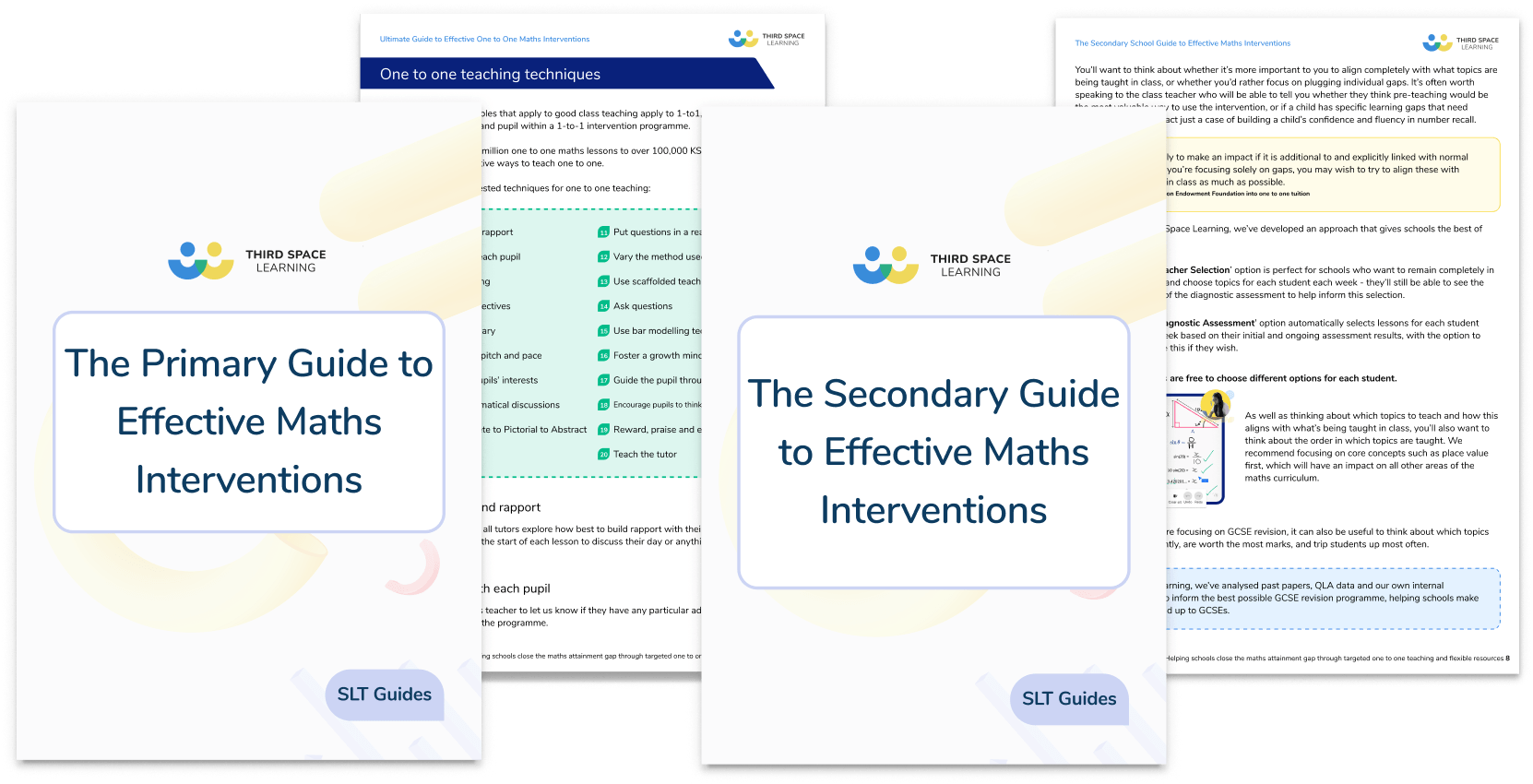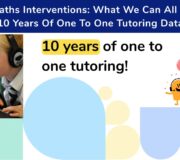What We’ve Learnt From Teaching Our Long Division Lesson 2,968 times
On average, our 1-to-1 maths lessons get taught thousands of times. In the run up to SATs week, we’ve got up to 6,000 pupils plugging gaps, developing their fluency, reasoning and problem solving with us, we might see a particular lesson has been chosen by teachers or recommended by our diagnostic tools, up to 500 times in a week. So we need to make sure these lessons aren’t just good but great lessons.
We feel very privileged to be able to teach so many pupils each week, but it also means we have a responsibility to make sure our lessons are the best they can be.
Every teacher knows what it’s like to teach a bad lesson once in a while, and inevitably you feel guilty when your class of 30 clearly haven’t ‘got it’ by the end, but generally the damage is fairly contained.
If we were to get a lesson wrong however at Third Space, the impact could be huge.
Fortunately I can confidently say we’ve never got a lesson ‘wrong’, but we’ve definitely had some lessons which weren’t achieving the same remarkable levels of progress (double expected in many cases) as others. In this article, we use a division lesson on as a case study to model to you how we improve our lessons to make them great.
The Ultimate Guide to Effective Maths Interventions
Find out how to plan, manage, and teach one to one (and small group) maths interventions to raise attainment.
Download Free Now!Read more: How To Teach Division KS2: Maths Bootcamp [7]
What to do when a lesson needs improvement
Generally when you feel you’ve taught a less than excellent lesson, unless it’s been observed, you, and potentially your teaching partner, are free to work on it together to improve it and try better next time.
For us, working with so many different schools and tutors, there are more moving parts so we’ve had to create a very robust process to make sure that for any lesson that doesn’t meet our stringent success criteria can be improved, and improved rapidly.
So to give you more detail on the process, I thought it might be interesting to share a recent piece of work I undertook to improve our Year 6 lesson on long division.
If you’re looking for more general resources, examples and tips on teaching division in the classroom, read our articles:
- What Is Division? Explained For Primary School
- Division Questions That Will Test Your Primary School Pupils
- Free Division Worksheets For Primary School: Year 2 to Year 6
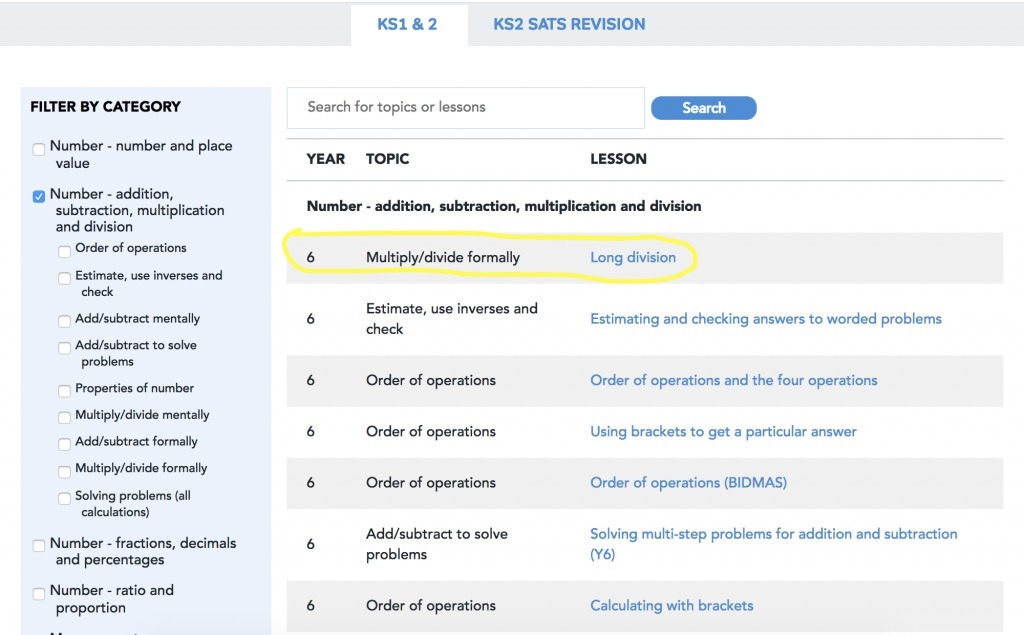
Case study: Making a good long division lesson great again!
The long division method is a tricky subject to teach at the best of times. You need to convey difficult concepts in an easy to understand way, allowing the pupil to take time to access and master each step. You can read more about how to teach division in this article.
The quantitative data we collect from every session every time a pupil and tutor sit down together was highlighting our long division lesson as a possible area for improvement.
While our tutors can personalise and adapt any lesson to the ability of the pupil taking it, our lesson on long division appeared to be providing a great deal of challenge no matter what the pupil’s prior attainment.
The majority of pupils simply weren’t completing all the steps in a lesson. They were still making progress and developing understanding of long division, but the tutor often didn’t have time in the lesson to get to the multi step reasoning and problem solving long division questions that we aim for all our lessons to progress to on every topic.
So the report that teachers would receive from us after a pupil had been taught the long division lesson would typically look that this with two of the lesson objectives not even started.
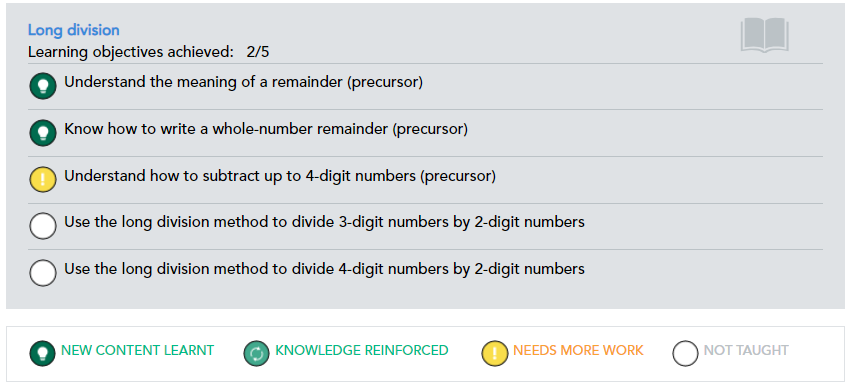
Long division lesson observations
Once we’d looked at the quantitative data we had on the success of this lesson, the next step in our process was to move on to qualitative analysis.
As part of our stringent safeguarding procedures and also to support tutor CPD, we record every lesson that takes place through Third Space Learning. The lesson on long division has been taught 2,968 times so we had in effect the option to watch 2968 recorded video of this lesson.
We chose to watch six recordings of the long division lesson to identify what features of the lesson might be tripping learners up. We also included tutor and pupil feedback in this process as we gather these from every lesson too.
This process enables us to identify what the the problem areas in a lesson might be so our team of experienced content creators can go in and improve them.
We then monitor the changes using the same metrics as previous so we can gauge success of the new lessons and judge if the improvements we’ve made have had a positive or negative impact. Making changes to a lesson is not something we take lightly and we only do it when we are confident that pedagogically what we are adding or taking away will improve outcomes for the pupil on that topic.
Step by step improvements to the long division lesson
For the lesson on long division, we identified three areas that we felt we could make an impact in changing:
- Differentiation
- Language
- Visuals
Take a look at how we went about it step by step.
1. Differentiation – Introducing a new way of teaching long division
There are a variety of methods that can be used to teach long division and choosing which one to learn should not only offer the pupil choice, but the ability to work with a method they are fully confident with.
The original lesson slide
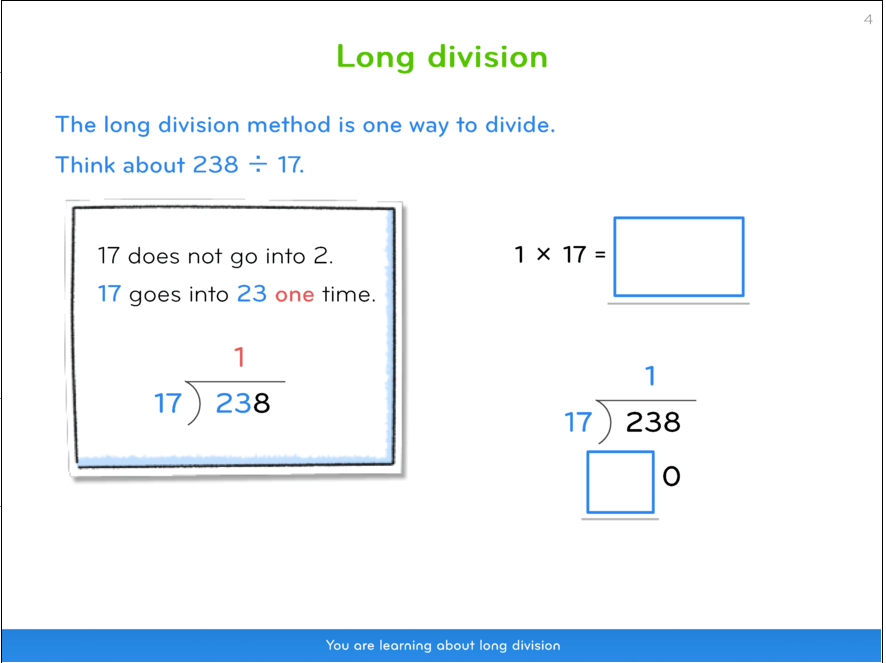
As can be seen here, our old lesson presented the formal long division method (sometimes known as ‘bus stop’ method) as the only option. This raises an immediate issue, particularly if the pupil has not been taught this method.
The new lesson slide
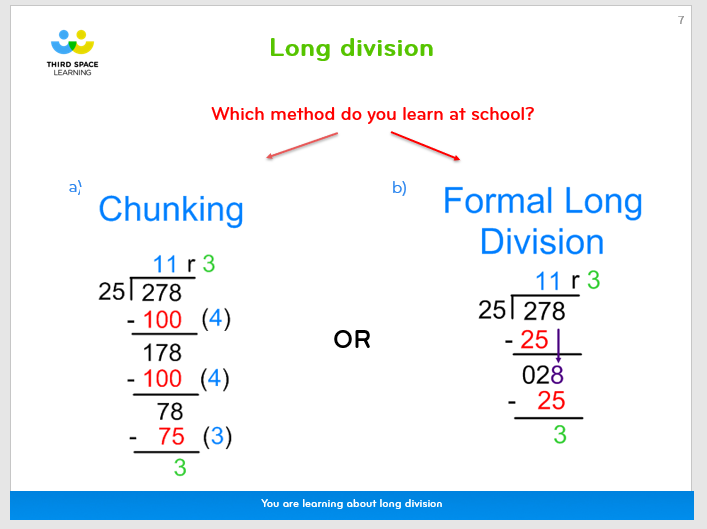
In our new lesson, two commonly taught methods, chunking and formal long division, are shown, giving the pupil the option to choose the method they would be studying in school, and allowing the pupil the autonomy to choose the method they are most comfortable with.
Each method is clearly represented by an example question, making it clear to the pupil what each term represents.
Read more: 8 Long Division Examples And How To Solve Them: Explained For Primary School
2. Language – Ensuring our tutors were communicating in a way pupils would understand
Long division is a complicated topic, made more so if confusing language is used. This leads to misconceptions.
The original lesson slide
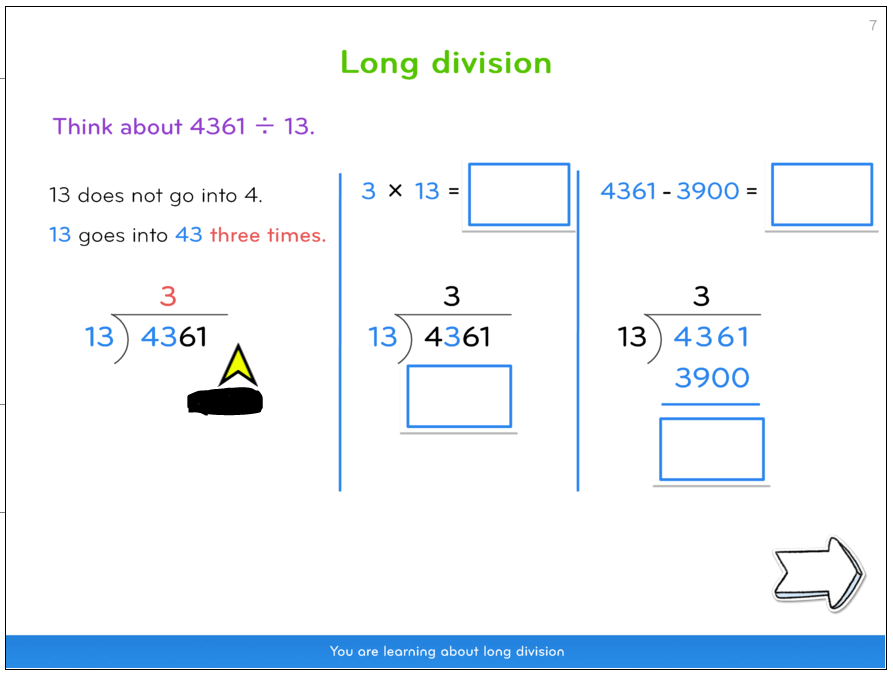
In this slide, we see the sentence “13 goes into 43 three times”. The phrase ‘goes into’ is confusing, failing to outline the concept of a number being divided into many parts.
Added to this is that instead of dividing the number into 4300, the pupil is told that 43 is being divided.
This confusing use of language meant that the pupil couldn’t understand what they were being taught and highlights that clear language is important when explaining a complicated theory.
The realisation that the language itself could lead to misconceptions meant that explicit instructions were needed for the tutors.
New notes for tutors
Accompanying every 1-to-1 maths lesson from the tutor’s view, there are tutor notes which give guidance to support the tutor to prompt the pupil with appropriate questions, or alternative ways of explaining concepts when a pupil is stuck.
Here’s what the original note to tutors looked like: In the long division method, we need to treat the column that the digit is in as a noun so when we say ‘how many 3s in 5 tens’ it is not the same as ‘how many 3s in 50’ – your answer should be in the number of tens, in this case 1 ten. Similarly, we would treat numbers in the hundreds, thousands, etc. columns in the same way when using the long division algorithm.
Here’s what we changed for the new note to tutors: When we saw that the language itself could lead to misconceptions we realised the tutors needed explicit instructions as to what to say when.
Accompanying the lesson from the tutor’s view, the example from the tutor notes now states that the column each digit is in should be treated as a noun. Instead of saying “how many 3s in 50”, tutors are instructed to say “how many 3s in 5 tens.”
This clearly reminds the pupil about the place value of each digit, as well as reinforcing the idea that they are dividing a group, not just a number – 5 tens not 50!
Each of our specialist maths tutors go through a specific 1-to-1 maths training to ensure that they can provide the high-quality, individualised primary maths tuition that has come to be expected of Third Space Learning. As well as our lessons, we are constantly improving the way we train our tutors. This article on how we take maths specialists from good to outstanding gives greater detail into the intitial tutor training and CPD.
3. Visuals – Making the lessons more engaging for pupils
Alongside the confusing language, the original lesson’s visuals did not aid clarity.
The original lesson slide
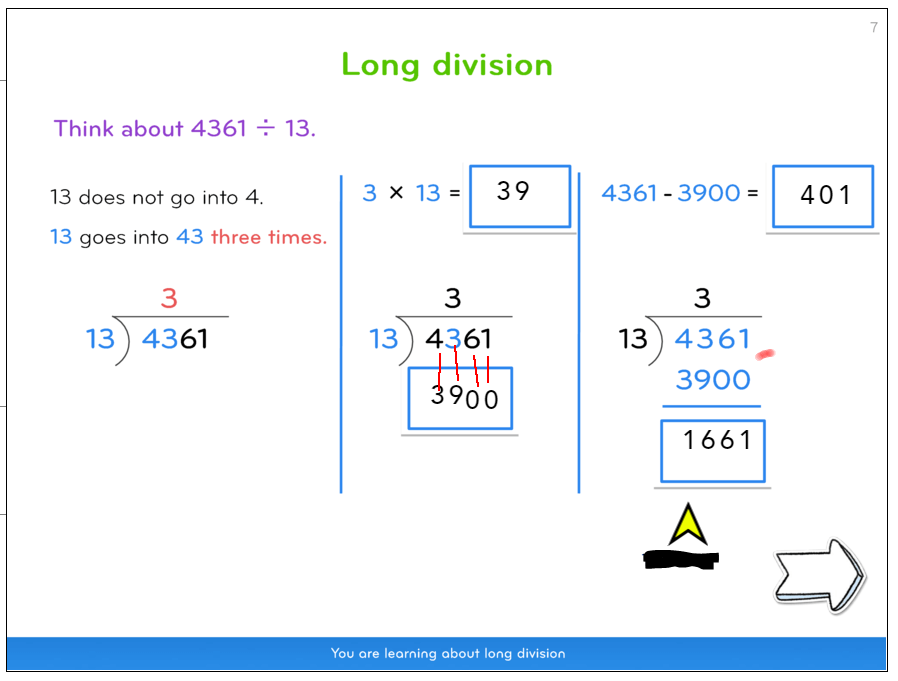
The pupil is shown a calculation and goes through it step by step; additional calculations are done outside the main calculation, and it’s difficult to make the link between them. As well as this, the colours used do not help to show what each number represents, leading the pupil to be unclear as to each number’s purpose.
(In the example above the pupil has typed the answers to the questions in the boxes)
The new lesson slide
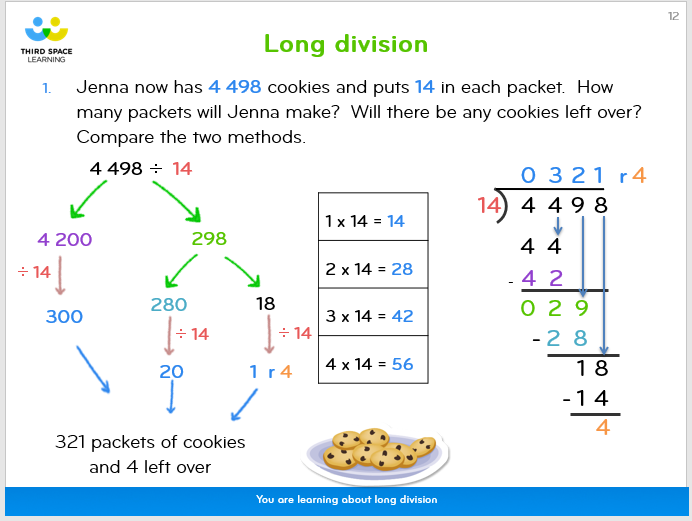
Our new lesson slide can instantly be seen to be anything but boring. Not only are there visuals in the form of different colours (each representing a part of the calculation), a table and a picture, but more importantly, the calculation has been placed in the concept of a story.
This instantly makes it more appealing to the pupil, as they are presented another person’s problem and asked to help solve it (not to mention there are cookies!) Children find it easier to understand theory when it is given a real life context that relates to them, and we’re working with a pictorial representation to help move their reasoning on.
Notably, the calculation itself has been set out in a number of ways, meaning the pupil can be guided carefully through the problem, fully understanding how each step has been worked out.
Judging the success of our long division lesson improvements
Our mastery approach like most schools is based around the fundamental concepts of CPA – Concrete, Pictorial, Abstract – suggesting that all lessons should involve each of these three ideas. Long division is an abstract concept, and while our original lesson outlined the theory, on reviewing it we could see it didn’t use enough visuals or set it out in a relatable situation that children would understand.
We feel our new lesson takes this abstract idea and makes it easy to understand through its clever use of visuals and its ability to set out a normal calculation within a contextualised, visual and concrete background.
The new long division lesson is now live on the platform. We are monitoring it closely to see the impact our changes have made and will report back when we have some more quantitative data. First impressions from the first few pupils who have been taught the lesson look very positive!
Read more:
DO YOU HAVE STUDENTS WHO NEED MORE SUPPORT IN MATHS?
Every week Third Space Learning’s maths specialist tutors support thousands of students across hundreds of schools with weekly online maths tuition designed to plug gaps and boost progress.
Since 2013 these personalised one to one lessons have helped over 150,000 primary and secondary students become more confident, able mathematicians.
Learn about our experience with schools or request a personalised quote for your school to speak to us about your school’s needs and how we can help.

